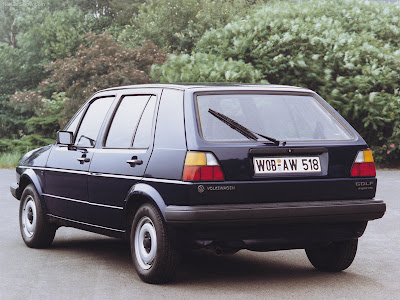September 1983 saw the introduction of the second-generation Golf Mk2 that grew slightly in terms of wheelbase, exterior and interior dimensions, while retaining, in a more rounded form, the Mk1's overall look. In 1985, the first Golfs with four-wheel-drive (Golf syncro) went on sale with the same Syncro four-wheel-drive system being employed on the supercharged G60 models, exclusively released on the continent in 1989 with 160 bhp (120 kW) and ABS braking.A Mk2-based second generation Jetta was unveiled in January 1984. There was no Mk2-based cabriolet model; instead, the Mk1 Cabriolet was continued over the Mk2's entire production run.
Volkswagen Golf 2 (Mk2)
Volkswagen Golf 2 (interior)
The Golf Mk2 was available as a 3- and 5-door hatchback. Its sedan sister car (available as a 4- and a 2-door model) was again called Jetta. No cabriolet version was developed from the Mk2; instead, the Mk1-based convertible continued to be produced, with minor changes.
Universal Red Mk2 - aka Golf 2
Volkwagen Mk2 - Golf 2 Country (all-road)
There was also a version called Golf Country (3,000 cars), designed for light off-road driving. It had more suspension travel, four-wheel drive, bullbars (generally over a single headlight grill), a skid plate for protecting the engine area, and a spare wheel mounted externally on the back.
In Europe, it was offered with the acclaimed 114 bhp (85 kW) 1.8 8v petrol engine. There were also: 160 "Country Allround"; 558 " Country - Chrompaket" with Chrome bullbars and beige leather interior; and 50 "Country GTI" for VW-staff. The Golf Country was particularly popular in Alpine regions in.
In Europe, it was offered with the acclaimed 114 bhp (85 kW) 1.8 8v petrol engine. There were also: 160 "Country Allround"; 558 " Country - Chrompaket" with Chrome bullbars and beige leather interior; and 50 "Country GTI" for VW-staff. The Golf Country was particularly popular in Alpine regions in.
Volkwagen Golf 2 GTI
The successful Golf GTI (or, in the USA, simply "GTI") was continued with the Mk2 as a sporty 3- or 5-door hatchback. Like late Mk1 GTIs, it featured a fuel-injected 1.8 litre four developing 112 PS (82 kW; 110 hp). In 1986 (1987 for North America) a Golf GTI 16V was introduced; here the 1.8 litre engine put out 139 PS (102 kW; 137 hp) (or 129 PS (95 kW; 127 hp) for the catalyst version) and the model was marked by discreet red and black "16v" badges front and rear. US/Canadian GTIs were later equipped with 2.0 16 valve-engines, available in the Passat and Corrado outside North America. In 1990, like the Golf, the GTI was given a facelift, and the "Big Bumper" became standard on all GTIs. This was maintained through the rest of the Mk2 model era. In 1990 the GTi G60 was also introduced featuring the 8v 1.8 with a G60 supercharger this version is not to be confused with the very rare G60 Limited.
Rallye Golf MK2
In 1989, the Rallye Golf appeared as a rallye "homologation special". Distinguishable by its box-flared wheel arches (similar to the Audi quattro, BMW E30 M3 and Lancia Delta Integrale) and rectangular projector headlamps, this model featured Syncro four-wheel drive, a cable shifted transmission and a G-supercharger 1763 cc (less than the typical 1.8L 1781 cc to meet the engine displacement rules) version of the injected 8 valve G60 1.8 liter engine.
5,000 cars were built in Volkswagen's Brussels, Belgium, plant, priced at about DM 50,000 each (or roughly twice as much as a base Golf GTI). The Rallye Golf has 161Bhp (118 kW).[7]
None were officially sold in the USA. Two were brought over officially for testing and when the Pan-Am Lockerbie Scotland bombing occurred the Volkswagen of America (VWOA) official that was in favor of selling them died, so did the hope of the these being sold in the USA.
5,000 cars were built in Volkswagen's Brussels, Belgium, plant, priced at about DM 50,000 each (or roughly twice as much as a base Golf GTI). The Rallye Golf has 161Bhp (118 kW).[7]
None were officially sold in the USA. Two were brought over officially for testing and when the Pan-Am Lockerbie Scotland bombing occurred the Volkswagen of America (VWOA) official that was in favor of selling them died, so did the hope of the these being sold in the USA.






No comments:
Post a Comment